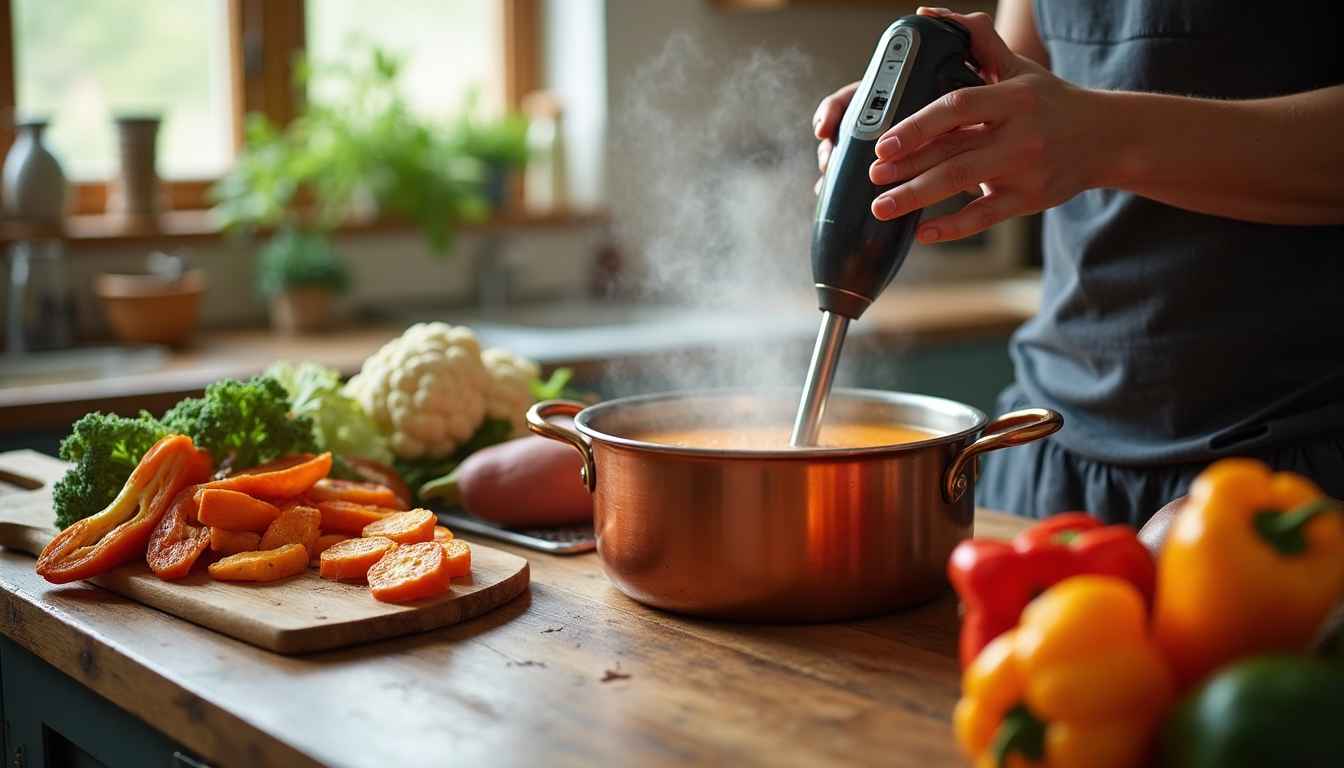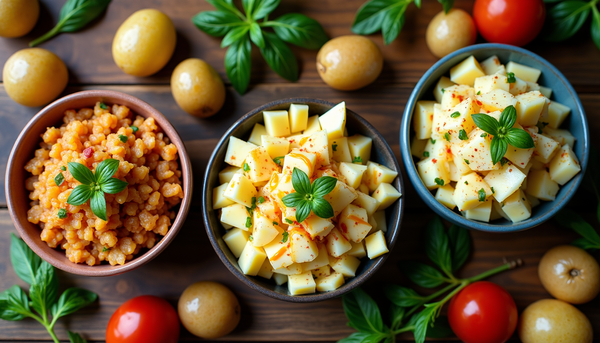Why I Stopped Following Soup Recipes (And Started Making Magic Instead)

I have a confession: I've become completely obsessed with making soup out of vegetables that my family initially rejected.
Not in a weird way—well, maybe a little weird. But hear me out.
Last month, I watched my three-year-old stare at perfectly roasted cauliflower like I'd just served him tiny white brains on a plate. The same kid who used to demolish roasted veggies was suddenly treating them like they were personally offensive. Sound familiar?
That's when I stumbled into what I'm now calling "jazz cooking"—and it completely changed how I think about soup.
The Problem with Perfect Recipes
Here's what nobody tells you about those beautiful, precise soup recipes floating around Instagram: they're lying to you. Not intentionally, but they're selling you this fantasy that cooking is about following instructions perfectly, measuring everything to the gram, and somehow achieving Pinterest-worthy results every single time.
Bullshit.
Real cooking—the kind that actually works in real kitchens with real families—is messy, improvisational, and deeply personal. It's more like jazz than classical music. You learn the basic structure, then you riff.
When I was staring at my toddler's veggie rebellion, I realized I'd been approaching soup all wrong. I was treating it like a recipe to execute rather than a problem to solve creatively.
The Alchemy of Acceptance
Think about it: soup is basically vegetable alchemy. You take ingredients that someone has rejected in their pure form and transform them into something completely different. Something comforting. Something that whispers "this is safe" instead of "this is vegetables, run!"
The magic isn't in the recipe—it's in understanding the psychology of what makes food feel welcoming.
Texture matters more than you think. My kid wasn't rejecting the flavor of cauliflower; he was rejecting the experience of cauliflower. The way it felt unfamiliar in his mouth, the way it looked suspicious on his plate. But purée that same cauliflower into a creamy, dreamy soup? Suddenly it's not cauliflower anymore—it's comfort.
This revelation hit me like a ton of bricks: we're not just cooking food, we're engineering experiences.
Jazz Cooking: The Art of Beautiful Imperfection
So here's what I started doing instead of following recipes religiously: I started treating soup-making like jazz improvisation.
The basic chord progression? Roast whatever vegetables are looking sad in your fridge. Add some kind of creamy element (coconut milk has become my ride-or-die, but heavy cream, cashew cream, whatever floats your boat). Introduce some umami depth with fire-roasted tomatoes or miso paste or even just good salt. Purée until smooth. Season until it tastes like home.
But here's where the jazz comes in: every single time I make this soup, it's different. Because jazz isn't about perfection—it's about responding to what's happening in the moment.
Last Tuesday, I had bell peppers that were getting wrinkly, sweet potatoes that needed to be used, and some random zucchini. Into the roasting pan they went with olive oil, salt, and whatever deity watches over weeknight dinners.
While they were roasting, I sautéed garlic until my kitchen smelled like heaven, then added vegetable broth (sometimes I use chicken broth—sue me), a can of coconut milk, fire-roasted tomatoes, and white beans because protein is important and beans add this incredible creaminess that people never expect.
The seasonings? This is where you get to be Thelonious Monk. Sometimes I go Mexican with cumin and smoked paprika. Sometimes I drift toward Thai territory with ginger and a touch of fish sauce. Italian nights get basil and oregano. Indian-inspired evenings might see some garam masala action.
The point is: there's no wrong note if you play it with intention.
The Technical Stuff (But Make It Personal)
Okay, let's talk technique without losing our souls to the recipe-industrial complex.
Roasting is your secret weapon. 425°F, 30-40 minutes, until everything looks a little charred and smells like concentrated happiness. This isn't just about cooking the vegetables—you're developing flavors that can't be achieved any other way. Those caramelized edges? That's where the magic lives.
The liquid ratios matter, but not obsessively. I usually start with 2-3 cups of broth, one can of coconut milk, and adjust from there. Too thick? Add more broth. Too thin? Let it simmer uncovered for a bit, or add more beans. This isn't rocket science.
Immersion blenders are the MVP of jazz cooking. None of this transferring hot soup to a regular blender nonsense. Stick that bad boy right in the pot and purée until you achieve your desired level of smooth. Some people like it completely uniform; I sometimes leave a few chunks because texture variety is interesting.
Season in layers. Salt your vegetables before roasting. Taste your soup before the final seasoning. Add acid (lemon juice, apple cider vinegar) if it tastes flat. Trust your palate over any recipe.
Seasonal Improvisation
This is where jazz cooking gets really fun: seasonal riffs on the basic theme.
Fall/Winter: Butternut squash, carrots, parsnips. Maybe some warming spices like cinnamon or cardamom. Swap the coconut milk for heavy cream if you're feeling indulgent.
Spring: Asparagus, peas, leeks. Brighten it up with fresh herbs at the end—dill is underrated in soup situations.
Summer: Zucchini, yellow squash, corn cut off the cob. Sometimes I throw in fresh basil or even mint for something unexpected.
The weird vegetables nobody knows what to do with: Fennel, turnips, rutabaga, kohlrabi—they all work. Soup is incredibly forgiving.
The Real Victory
Here's what I discovered through all this experimentation: my toddler isn't the only one who's been converted. My wife, who used to view soup as "not real dinner," now requests it specifically. My mother-in-law, who has Opinions about my cooking, admitted this soup "actually has flavor."
But the real victory? I stopped being afraid of my own kitchen.
When you approach cooking like jazz instead of classical music, you develop intuition. You start understanding how flavors work together, how textures can be manipulated, how the same basic ingredients can become completely different experiences based on technique and seasoning.
You also stop being dependent on other people to tell you what tastes good.
Your Turn to Improvise
So here's my challenge for you: stop following soup recipes. Start with this basic framework—roasted vegetables, creamy element, broth, seasonings, purée—and make it yours.
What vegetables have been giving you the stink eye from the crisper drawer? What flavors make you feel at home? What would happen if you combined them in a pot and applied some heat?
The worst that can happen is you make something mediocre and learn something for next time. The best that can happen? You discover your own signature soup that becomes the thing people request when they're feeling sick or sad or just need to remember that the world can be delicious.
And if you're dealing with picky eaters—whether they're three years old or thirty-three—remember that you're not just making soup. You're creating positive food experiences. You're proving that healthy can be comforting, that vegetables can be welcoming, that dinner doesn't have to be a battle.
Start with this basic riff, then make it yours. Because the best soup isn't the one that follows the recipe perfectly—it's the one that makes everyone at your table ask for seconds.
What vegetables are you going to transform first? Drop a comment and let me know how your soup jazz session turns out. Bonus points if you include what went wrong—that's where the best learning happens.




